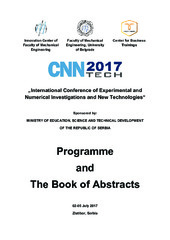Приказ основних података о документу
EXPERIMENTAL ANALYSES OF THE IMPLANT SUPPORTED ALL-CERAMICS
| dc.creator | Tanasić, Ivan | |
| dc.creator | Šakota, Dušan | |
| dc.creator | Atanasovska, Ivana | |
| dc.creator | Mitrović, Nenad | |
| dc.date.accessioned | 2023-12-28T13:20:37Z | |
| dc.date.available | 2023-12-28T13:20:37Z | |
| dc.date.issued | 2017 | |
| dc.identifier.isbn | 978-86-7083-938-0 | |
| dc.identifier.uri | https://machinery.mas.bg.ac.rs/handle/123456789/7682 | |
| dc.description.abstract | The aim of this study was to present the possibility for digital image correlation (DIC) and finite element analysis (FEA) investigation of ceramic crowns placed on angulated and non angulated implants. Additionally, to determine strain in models composed of all-ceramics supported by angulated and non angulated implants with or without platform switching. Three-dimensional finite element (FE) and the digital (DIC) models of the Strauman cylindrical dental implant systems (4 x 12 mm; Straumann, Basel, Switzerland) placed in the polyurethane resin (F16, Axson Technologies, France) block with an inclination of the vertical axis in interval of +1, -1 and -3 degrees were created. Additionally, control FEA and DIC models with straight implants (one for each analyzing system) were created to support results obtained for models with inclined implants. Height of the block was 14.5 mm and length 11.5 mm. The width of the sample was 13 mm. The implants were placed so that their outer diameter surface was 2 mm away from the surface of interest, measured in the straight orientation (0˚). The strain was observed at two locations i.e. modes – “block implant” interface (cross section), and in the area of interest. Solid modeling for the implant and block model was performed in Ansys 13.0 APDL Multyphysics in Windows 7 OS. Finite Element analysis was performed in Ansys 13.0 by Sparsesolver. Solidworks 2015 Academia (Dassault Systemes) was used for creating block mold models. Overall von Mises strain for every sample was calculated by averaging strain values in cervical, middle and apical region. Increase of the angle of inclination increased overall strain in the apical region of the DIC and FEA models. DIC mode confirmed findings supported by FEA modes, so FEA models validate DIC models. | sr |
| dc.language.iso | en | sr |
| dc.publisher | Innovation Center of Faculty of Mechanical Engineering | sr |
| dc.rights | openAccess | sr |
| dc.source | International Conference of Experimental and Numerical Investigations and New Technologies CNN TECH 2017 | sr |
| dc.subject | Implant supported all-ceramic | sr |
| dc.subject | digital image correlation method | sr |
| dc.subject | finite element analysis | sr |
| dc.subject | angled implants | sr |
| dc.title | EXPERIMENTAL ANALYSES OF THE IMPLANT SUPPORTED ALL-CERAMICS | sr |
| dc.type | conferenceObject | sr |
| dc.rights.license | ARR | sr |
| dc.citation.spage | 31 | |
| dc.identifier.fulltext | http://machinery.mas.bg.ac.rs/bitstream/id/19236/bitstream_19236.pdf | |
| dc.identifier.rcub | https://hdl.handle.net/21.15107/rcub_machinery_7682 | |
| dc.type.version | publishedVersion | sr |


